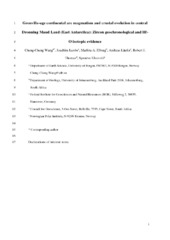| dc.contributor.author | Wang, Cheng-Cheng | |
| dc.contributor.author | Jacobs, Joachim | |
| dc.contributor.author | Elburg, Marlina A. | |
| dc.contributor.author | Läufer, Andreas | |
| dc.contributor.author | Thomas, Robert J. | |
| dc.contributor.author | Elvevold, Synnøve | |
| dc.date.accessioned | 2020-06-15T11:15:09Z | |
| dc.date.available | 2020-06-15T11:15:09Z | |
| dc.date.issued | 2020 | |
| dc.Published | Wang C, Jacobs J, Elburg MA, Läufer A, Thomas RJ, Elvevold S. Grenville-age continental arc magmatism and crustal evolution in central Dronning Maud Land (East Antarctica): Zircon geochronological and Hf-O isotopic evidence. Gondwana Research. 2020;82:108-127 | eng |
| dc.identifier.issn | 1342-937X | en_US |
| dc.identifier.issn | 1878-0571 | en_US |
| dc.identifier.uri | https://hdl.handle.net/1956/22590 | |
| dc.description.abstract | This study focusses on the Grenville-age Maud Belt in Dronning Maud Land (DML), East Antarctica, which was located at the margin of the Proto-Kalahari Craton during the assembly of Rodinia. We present new U–Pb zircon ages and Hf–O isotope analyses of mafic and granitic gneisses exposed in the Orvin-Wohlthat Mountains and Gjelsvikfjella, central DML (cDML). The geochronological data indicate continuous magmatic activity from 1160 to 1070 Ma which culminated at 1110–1090 Ma, followed by high-grade metamorphism between 1080 and 1030 Ma. The majority of zircons from the Orvin-Wohlthat Mountains exhibit radiogenic Hf isotopic compositions corresponding to suprachondritic εHf (t) values and Mesoproterozoic model ages, indicating crystallization from predominantly juvenile magmas. However, the involvement of ancient sedimentary material, which were most likely derived from the adjacent Proto-Kalahari Craton, is revealed by a few samples with negative to neutral εHf (t) and significantly elevated δ18O values (8–10‰). Samples from further west, in Gjelsvikfjella have more mantle-like zircon O isotopic compositions and late Paleoproterozoic Hf model ages, indicating the incorporation of ancient, previously mantle-derived continental crust. The rocks in cDML, thus define part of an extensive Mesoproterozoic magmatic arc with subduction under the Proto-Kalahari margin. This involved significant growth of new continental crust, possibly related to slab retreat, accompanied by subordinate recycling of older crustal components. The Maud Belt has previously been correlated with the 1250–1030 Ma Natal Belt in southern Africa, which lay to the west in the context of Gondwana, although this assertion has recently been questioned. Our study supports the latter view in demonstrating that the continental arc magmatism in the Maud Belt appears to be temporally and tectonically unconnected to the accretion of (slightly older) juvenile oceanic islands in the Natal Belt, which, in contrast to the Maud Belt, show subduction polarity away from the craton. We thus speculate that the Namaqua-Natal to Maud Belt contact (exposed in the Heimefront Shear Zone) may represent a changed tectonic environment from arc/continent-continent collision to slightly younger continental margin orogenesis at the westernmost termination of this part of the global Grenville Orogen. The Maud Belt marks the beginning of a major, long-lived accretionary Andean-type tectonic regime on the eastern margin of Proto-Kalahari in the Meso-Neoproterozoic during Rodinia assembly and break-up until the formation of Gondwana. | en_US |
| dc.language.iso | eng | eng |
| dc.publisher | Elsevier | en_US |
| dc.rights | Attribution-NonCommercial-NoDerivs CC BY-NC-ND | eng |
| dc.rights.uri | http://creativecommons.org/licenses/by-nc-nd/4.0/ | eng |
| dc.title | Grenville-age continental arc magmatism and crustal evolution in central Dronning Maud Land (East Antarctica): Zircon geochronological and Hf-O isotopic evidence | en_US |
| dc.type | Peer reviewed | |
| dc.type | Journal article | |
| dc.date.updated | 2020-02-17T09:34:24Z | |
| dc.description.version | acceptedVersion | en_US |
| dc.rights.holder | Copyright 2019 Elsevier | en_US |
| dc.identifier.doi | https://doi.org/10.1016/j.gr.2019.12.004 | |
| dc.identifier.cristin | 1778602 | |
| dc.source.journal | Gondwana Research | |
| dc.relation.project | Universitetet i Bergen: 812378 | |
| dc.subject.nsi | VDP::Matematikk og naturvitenskap: 400::Geofag: 450 | |
| dc.subject.nsi | VDP::Mathematics and natural scienses: 400::Geosciences: 450 | |
| dc.identifier.citation | Gondwana Research. 2020, 82, 108-127. | |

